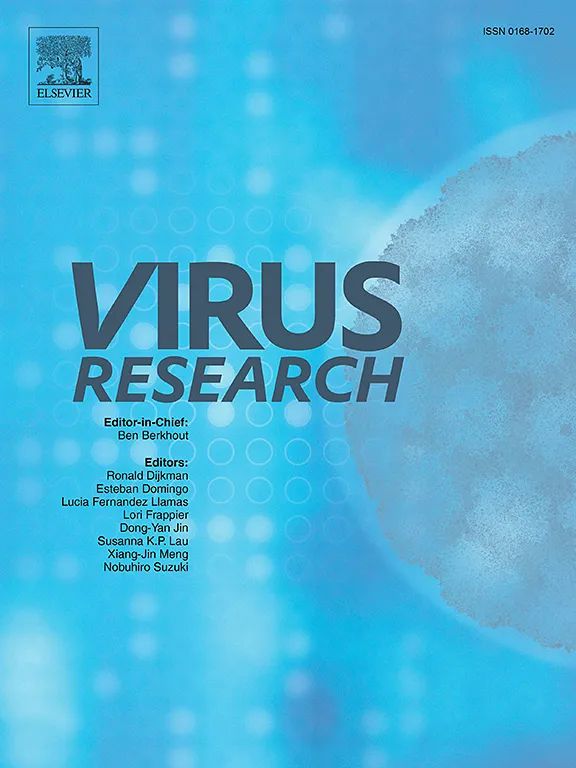Genetic characteristics and pathogenesis of clade 2.3.4.4b H5N1 high pathogenicity avian influenza virus isolated from poultry in South Korea, 2022–2023
IF 2.7
4区 医学
Q3 VIROLOGY
引用次数: 0
Abstract
During the 2022–2023 winter season in South Korea, a novel clade 2.3.4.4b H5N1 HPAIV was first detected in wild birds, which then subsequently caused multiple outbreaks in poultry farms and wild birds. This study aimed to investigate the genetic characteristics of H5N1 HPAIVs isolated during the 2022–2023, along with their pathogenicity and transmissibility in chickens and ducks. The clade 2.3.4.4b H5N1 HPAIV viruses caused outbreaks in 75 poultry farms and detected in 174 wild bird cases. Phylogenetic analysis of hemagglutinin genes revealed that the South Korean H5N1 HPAIV isolates were closely related to Eurasian and American HPAIVs isolated between 2022 and 2023. In total, 21 diverse genotypes (22G0–22G20) were identified in virus isolates from poultry and wild birds, among which 22G7 was the dominant genotype. The 22G1 genotype (A/duck/Korea/H493/2022(H5N1)) caused high virulence and pathogenicity, with a 100 % mortality rate in specific-pathogen-free chickens. Ducks inoculated with genotypes 22G1 or 22G7 (A/duck/Korea/H537/2022(H5N1)) showed neurological signs, with 60 %–80 % mortality rate. In the contact groups of ducks, 100 % of transmissibility was observed. Notably, in the 22G7-inoculated group, viral shedding via the cloacal route was longer, and viral replication in the cecal tonsil was higher than that in the 22G1-inoculated group, which may have contributed to the dominancy of the 22G7 genotype. Therefore, better understanding of the genetic and pathogenic features of HPAI viruses is important for effective virus control in the field.
2022-2023年韩国家禽中分离的2.3.4.4b支H5N1高致病性禽流感病毒的遗传特征和发病机制
在韩国2022-2023年冬季期间,首次在野生鸟类中发现了一种新的进化枝2.3.4.4b H5N1型HPAIV,随后在家禽养殖场和野生鸟类中引起了多次暴发。本研究旨在调查2022-2023年间分离的H5N1型hpaiv的遗传特征,以及它们在鸡鸭中的致病性和传播性。2.3.4.4b支H5N1 HPAIV病毒在75个家禽养殖场暴发,并在174例野鸟中检测到。血凝素基因系统发育分析显示,韩国H5N1型HPAIV分离株与2022年至2023年间分离的欧亚和美洲HPAIV密切相关。从家禽和野生鸟类分离的病毒共鉴定出22g0 ~ 22g20的21种不同基因型,其中22G7为优势基因型。22G1基因型(A/duck/Korea/H493/2022(H5N1))具有高毒力和致病性,在无特定病原体的鸡中死亡率为100%。接种22G1或22G7 (A/duck/Korea/H537/2022(H5N1))基因型的鸭出现神经症状,死亡率为60% ~ 80%。在接触群中,观察到100%的传播率。值得注意的是,与22g1接种组相比,22G7接种组的病毒通过生殖道途径的脱落时间更长,盲肠扁桃体中的病毒复制量也更高,这可能是22G7基因型占优势的原因。因此,更好地了解高致病性禽流感病毒的遗传和致病特征,对现场有效控制病毒具有重要意义。
本文章由计算机程序翻译,如有差异,请以英文原文为准。
求助全文
约1分钟内获得全文
求助全文
来源期刊

Virus research
医学-病毒学
CiteScore
9.50
自引率
2.00%
发文量
239
审稿时长
43 days
期刊介绍:
Virus Research provides a means of fast publication for original papers on fundamental research in virology. Contributions on new developments concerning virus structure, replication, pathogenesis and evolution are encouraged. These include reports describing virus morphology, the function and antigenic analysis of virus structural components, virus genome structure and expression, analysis on virus replication processes, virus evolution in connection with antiviral interventions, effects of viruses on their host cells, particularly on the immune system, and the pathogenesis of virus infections, including oncogene activation and transduction.
 求助内容:
求助内容: 应助结果提醒方式:
应助结果提醒方式:


